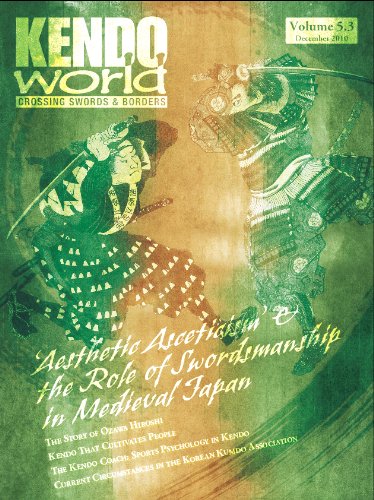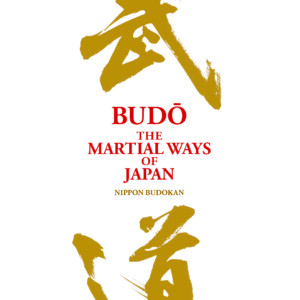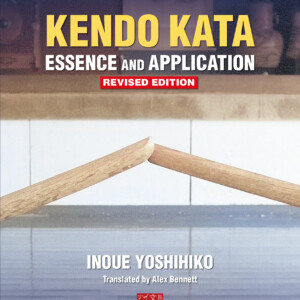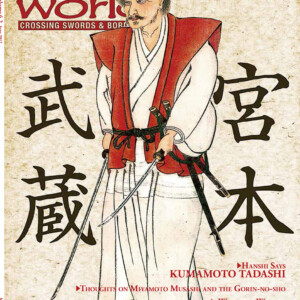
Kendo World 5.3

Editorial
Alex Bennett Ph.D
“Without question, kendo is a fantastic way for developing character. Even the dan grades and shōgō in kendo are based on the premise that by virtue of improving technically, you will also mature as a human being. My point is that we must be wary of some particularly disturbing common misconceptions; you do not improve as a human being just because you do kendo, or just because you have a high grade. It is a simple notion, but one that is not contemplated enough by kendo enthusiasts in and outside Japan.”
In Memoriam: Dr.(Lt. Col.) Gordon Warner, USMC (Ret.)
Professor Richard Schmidt (University of Nebraska-Lincoln)
Dr. (Lt. Col.) Gordon Warner, USMC (Ret.), 97, passed away Friday, March 4, 2010, in Okinawa (Yonabaru-chō), Japan, following a brief illness. In the world of modern kendo, Dr. Warner is best known as one of several American and Nikkei kenshi pioneers who played a seminal role in forging strong cross-cultural linkages between Japan and the United States in fostering further the internationalisation of kendo. Professor Richard Schmidt writes about this great man’s life and contributions to kendo.
Hanshi Says “8 Important Points for Shinsa”
Professor Satō Nariaki (Hanshi 8-dan)
A series in which some of Japan’s top Hanshi teachers give hints of what they are looking for in grading examinations based on wisdom accumulated through decades of training. Satō Nariaki Sensei is one of the most well-known kendo masters on the international kendo scene, and he gives the reader a clear understanding of what examiners are looking for in high-level promotion examinations: “The fundamental content of kendo, especially the technical aspects of attacking or defending (including psychological strength) along with aspects of character development, such as panache (fūkaku) and a commanding presence (kigurai) that come with a high level of improvement, are all factors for assessment that have been outlined in previous articles. I would like to limit my article to kamae and posture, maai and seme, and striking chances.”
The Nuts and Bolts of Kendo: “Tsuba-zeriai”&“Tai-atari”
Nakano Yasoji, (Kendo Hanshi 9-dan)
Nakano Sensei analyses the important points for executing tsuba-zeriai and tai-atari. “Just moving into close proximity with the body without connecting the tsuba is not tsuba-zeriai. Instructors should make students understand this issue for the sake of good kendo.”
Reidan-jichi – The Greater Meaning of Kendo: Maai
Professor Ōya Minoru (International Budo University, Kyōshi 7-dan)
In his on-going series, Professor Ōya takes a close look at the various maai (intervals) used in kendo, and their deeper meaning. “A kendo match based on the realities of maai does not begin with a stand-off from issoku-ittō-no-maai; neither should it be an exchange of blows from that distance; nor is issoku-ittō-no-maai the point where seme begins. The process of moving from a distance where your sword tips are apart or barely touching (one where you cannot reach each other even if you step forward with the attack) into one in which the shinai cross (issoku-ittō-no-maai) is one which demands great psychological and technical preparedness, and one in which it is crucial that you detect any movements in your opponent. Thus this process of closing the distance is extremely significant in kendo.”
Historical Sightseeing “Hokuriku Region”
Written and photographed by Bruce Flanagan MA
In this instalment of “Historical Sightseeing, intrepid traveller and KW senior staff writer Bruce Flanagan investigates a selection of historically-significant tourist locations accessible from the Hokuriku Jidōsha-dō, an expressway stretching almost 500km north-east from Maibara near Lake Biwa to Niigata Prefecture. Although the expressway begins in Shiga Prefecture in the Kinki Region, it continues on to traverse the four adjacent prefectures which make up the Hokuriku Region of central Honshū; namely Fukui, Ishikawa, Toyama and Niigata prefectures, all of which share coastline along the Sea of Japan. The sites featured in this article are from Ishikawa and Fukui.
‘Aesthetic Asceticism’ & the Role of Swordsmanship in Medieval Japan
Alex Bennett Ph.D.
This essay investigates the symbolic reverence attached to the sword (Nihon-tō) in medieval and early-modern Japan, and the genesis of ‘schools’ dedicated to the study and refinement of its techniques. To this day, many scholars still take it for granted that the Nihon-tō was the primary or preferred weapon of the bushi. However, for most of bushi history the sword was actually no more than an auxiliary weapon. Nevertheless, from the fifteenth century onwards, we see the gradual rise of specialist martial art schools (ryūha) in which the sword became the predominant weapon. This trend seems to be at stark odds with the reality of the era marked by brutal warfare in which warlords (daimyō) vied to crush each other to gain suzerainty over the country, and begs the question of why schools dedicated to swordsmanship arose in the first place. If its value as a battlefield weapon is questionable, what was it that set the sword apart from other weapons?
A Duffle Bag & a Bogu Bag Part 6: Brilliant Cultural Boundary Crossover
Imafuji Masahiro MBA
International musha-shugyōsha Imafuji Masahiro tackles the complex issue of cultural give-and-take. “Since I started “Dojo2Go” (an online kendo instruction website – now called Kendo-Guide.com), I have been thinking how kendo can be practised in other countries. Should kendo adapt to different cultures? Or, should people adapt to kendo…? Why do people do kendo? Is it because they are fascinated by samurai culture? Is it because they like the concept and history of kendo (related to samurai)? Is it because kendo is quite simply “cool”? Whatever the reason each person has for doing it, I used to think that kendo should be the same. For example, there are people who cannot rei (bow) in the traditional Japanese way because of their religious beliefs, but they understand perfectly why we need to bow. So what should they do? What should kendo do about those who cannot follow kendo protocol the way it is prescribed in Japan?”
Unlocking Japan
Lockie Jackson Ph.D.
In this issue, long-time Aussie expat and resident curmudgeon Dr. Jackson delves into the world of the soushoku-danshi (aka “budgie Boys”)…“I am certainly not against Japanese men being comfortable enough with their own masculinity to express their softer sides. In any case, I wonder whether kendo might not provide an interesting lens through which to view gender in Japan, and the extent to which gender roles and expected modes of behaviour can be said to be changing.”
Kendo Clinic: Adhesive Capsulitis or “Frozen Shoulder”
Arima Saburō MD & Michael Komoto MA (KATSUURA ORTHOPAEDIC CLINIC)
In the kendo community, we often hear of people suffering from stiff shoulders. With the great stresses put on the upper body in kendo activity this is of little surprise, and so we may be inclined to dismiss these reports as complaints about the same troubles we all encounter sometime in the course of our kendo study. However, there is a specific, commonly occurring shoulder ailment that inflicts constant pain on the sufferer, severely limiting the use of their arm. Adhesive Capsulitis or “Frozen Shoulder” is a condition in which pathological (disease) processes occur in the shoulder joint, normally going through stages over a period of a year to several years. Hardly a normal “ache and pain” of regular exercise, pathological processes are at work, resulting in changes in the tissues of the shoulder, and accordingly, reduction of the function of the joint. Do you suffer from this? Read all about it here.
Learning and Enjoying Kendo
Shimokawa Mika (NIFS Kendo Coach and Japanese National Team Member)
Shimokawa Mika is a coach at the university kendo powerhouse, the National Institute for Fitness and Sports in Kanoya. She writes about her basic kendo philosophy. “One of the attractive features of kendo is the fact that both men and women of all ages can participate in keiko together. In more recent times however, there has been an increase in training specifically for women. I am of the belief that training with numerous people (both male and female) is an important means to discover and develop various strategies and techniques, and improve one’s overall quality of kendo.”
Kendo that Cultivates People Part 11: The Conclusion of Tanren-ki and Preparation for Seijuku-ki (Maturity)
Professor Sumi Masatake (Hanshi 8-dan) (Translated by Honda Sōtarō Ph.D.)
Sumi Sensei continues his acclaimed series on instructing youth into the next stage of maturity and development. “In Japan, many young students of kendo often belong to senior high school and university kendo clubs and so are able to train together with their friends or classmates under the supervision of an instructor. Upon entering the workforce however, they often have fewer opportunities to train, and their job and new lifestyle will dictate if they can continue training or not. Adult practitioners of kendo generally have to give priority to their work or family, and in doing so their determination to continue kendo has to be quite strong if they hope to find the time to go to keiko. By the time a kendo practitioner leaves school they should have completed their tanren-kiphase, and to a large extent be capable of independence in their kendo. In this instalment I will describe how students should conclude their training at school, and how they can prepare to become adults and contributing members of society.”
Some Thoughts on the “Art of Kantoku”
Professor Kanzaki Hiroshi (Osaka University of Health and Sport Science, K 8-dan)
Professor Kanzaki, young 8-dan and highly successful kendo instructor offers some clues in the workings of the Kantoku mind… “Above anything in kendo shiai, the ultimate goal is to win, and for this reason, the line-up of members is a critical consideration in team strategy. Miyamoto Musashi’s The Book of Five Rings addresses matters in both individual contests (ichibun-no-heihō) and group encounters (ōbun-no-heihō). His philosophy of ōbun-no-heihō or “the strategy of large scale battle” does not relate directly to the individually fought matches in kendo team fights. However, adaptation of his ideas can provide us with many useful themes for reference in modern kendo.”
The Kendo Coach: Sports Psychology in Kendo Part 4 — Self Confidence and Goal Setting
Blake Bennett MSc
Following on from previous articles — in pursuit of an ideal performance state through mental training — this instalment of the “Kendo Coach” series will cover the final element of the ‘Big 3’ cited in the sport psychology literature – “Self-Confidence”. While the research concerning this topic is abundant in the sport psychology world, this review will provide a simple summary of the main points regarding self-confidence in the sporting arena. Maintaining the “Kendo Coach” series theme of providing practical methods and recourse for coaches to develop mental skills in their kendo athletes, the second section of this article will present a summary of ‘Goal Setting’ considerations with a hands-on worksheet as a suggested method to help practitioners achieve their ideal performance state.
The Story of Ozawa Hiroshi
Stuart Gibson
Author of the celebrated book Kendo: The Definitive Guide recently passed the remarkably difficult 8-dan examination. Stuart Gibson talks with him about his journey. “Walking to a local Chinese restaurant with Ozawa Sensei after keiko one day, we were chatting about recently passing his hachidan exam, and about the length of time involved since his first attempt, at 46 years old: ‘The young guys, the ones that pass the first time, or maybe at 48 or 49 years old, they don’t have a story. I tried for my hachidan for more than ten years. I’ve got a story.’ This is that story…”
The Silent Kai — Deaf Students and Kendo — The Kagami Shin Dojo and Tim
Dee Hanson
Dee Hanson introduces one of her dōjō mates. “Deafness in sport is more of an impairment than a disability. Deaf people participate in mainstream sport and martial arts such as judo and kendo. Yet at first glance the nature of kendo would present unique obstacles to the deaf participant. An instructor or dōjō member may have limited experience in communicating with a deaf student. Once in bōgu, matters are compounded as visual cues such as facial expression and hand gestures become restricted. Lip reading is not an easy skill to acquire, and trying to read someone’s silent mouthing from behind a set of bars is an art known only those victims of repressive governments. Although these are problems, they do not need to be barriers. For an imaginative dōjō it can open up a new way of doing things.”
The Last Manga Exhibition: Musashi gets the ending he deserves
Christopher Hellman
Miyamoto Musashi is perhaps the most famous of all the many swordsmen Japan has produced over the centuries, both in Japan and abroad. Books written by Musashi, principally Gorin-no-Sho, and those about him, continue to sell well. He has also been the subject of many movies, TV shows, novels and plays. Given that he was himself an artist, it is fitting that in recent years, the most powerful reworking of his story has been in the visual arts, at the hands of the manga writer and artist Inoue Takehiko. Christopher Hellman tells us about Inoue’s contribution to the Musashi Legacy.
Kendo’s Not-so Common-sense: The HAKAMA
Professor Nagao Susumu (Meiji University Kendo K 8-dan)
QUESTION: Why do we wear hakama in kendo? Why are there pleats and a koshi-ita? Has the hakama always been as long in the leg as is commonly seen in kendo nowadays? Read Prof. Nagao’s fascinating article to find out all about our beloved hakamas.
The attraction of the Way of the Sword
Yoshino Eizō (Waseda Graduate)
(Translation and editing by Dr. Stephen R. Nagy)
This article forms part of a series of contributions found in a publication commemorating the centennial anniversary of the Waseda University Kendo Club, the current All-Japan collegiate men’s and women’s team champions. Each article contains the impressions, experiences and interpretations of former members of the Waseda University Kendo Club in the turbulent years leading up to the Second World War. They provide us some insight into what kendo training used to be like, while at the same time are useful in helping the modern practitioner connect their contemporary practice to kendo legends of a bygone era. In this article, the late Yoshino Eizō Sensei shares with us his view on “The attraction of the Way of the Sword” as forged through his experiences in the Waseda University Kendo Club and interaction with his sempai.
sWords of Wisdom
By Alex Bennett
“The Mind of Abandonment” 払い捨てる心 “Discard all of the things you have learnt. Throw away your waza, and the next wazawill be born.” This famous kendo maxim was conceived by legendary swordsman Itō Ittōsai. What does it mean, though?
A Brief Overview of Pre-WWII Kendo in Brazil – Part II By
Dr. Luiz Kobayashi
In the previous issue Dr. Kobayashi presented a short outline of the introduction and early developments of kendo in Brazil until the outbreak of the Second World War. This article follows on from this period, and offers a synopsis of kendo in Brazil during and after the war, and is a valuable contribution in recording kendo’s history around the world. Dr. Kobayashi is an authority on kendo history and recently published “Peregrinos do Sol” (“Pilgrims of the Sun”), arguably the first book to explain the birth and development of kendo in depth in Portuguese.
EXHIBICION DE ARTES MARCIALES 2010: BUDŌ JAPONES EN MEXICO
Dr. Carlos Horita
In 1609, four-hundred years ago, the galleon “San Francisco” was shipwrecked in Japan when travelling from Manila to Acapulco (Mexico), this happening represents the first official contact between Japan and Mexico. The following year, in 1610, survivors of the wreck returned to Mexico on a boat offered by the shogunate. Japan and Mexico have since developed a bilateral relationship in various fields. In order to celebrate four centuries of diplomatic relations between Mexico and Japan, in 2010 a series of cultural events were organised, including a “Budo Exhibition”. Dr. Carlos Horita reports on this historical event and its significance to the kendo community in Mexico.
Kendo holiday in Japan WOW!!
Alicia Wong
Along with her husband David, and another club mate, Ramon, three resolute Kiwi kenshi travelled from Christchurch, New Zealand to Japan for three weeks of kendo. They spent the bulk of their time in the countryside in the outskirts of Osaka, where we trained with the kendo club at Osaka University of Health and Sport Science. Read about their “kendo trip of a lifetime”.
I ♥ China
By Bryan Peterson
Kendo was one of the thirteen martial arts being showcased in the first SportAccord Games, an event that aspires to be a regular gathering of martial artists from around the world. KW staff Bryan Peterson and Michael Komoto were there to cover the event. Bryan in particular is an old hand in China. “Most of the time, I really love China. Like when I am walking down a Beijing street at 2am and spy someone practising the martial art of xing yi quan on the sidewalk in front of an apartment building. As I also studyxing yi quan, I thought it most fortuitous and walked over… We got to chatting and began comparing notes on basics and forms from our two slightly different strains of xing yi quan. It was just the right combination of spirited and friendly. I cracked open a beer, he lit up another cigarette, and we exchanged goodbyes… This time, though, I was in China for a Japanese martial art.”
Kendo in Shanghai
By Alfred Tan
Kendo in Shanghai started over ten years ago at the Shanghai Japanese School. At that time its members were primarily expat Japanese businessmen and their families with a very few locals. Around 2003, Iwaya Takayuki Sensei started nurturing the first group of local students and clubs outside of the Japanese school to expand kendo to the local population. Over the years, kendo has blossomed with several of Iwaya Sensei’s early students starting dōjō in various parts of the city. Today, Shanghai has several strong dōjō with over 300 practitioners drawn from the local and expat population from all over the world. Alfred Tan introduces some of the characters on the kendo scene in Shanghai. “At any training, I could find myself practising with kenshi from Germany, Singapore, Holland, Taiwan, Japan, Malaysia, and of course Shanghai.”
Current Circumstances in the Korean Kumdo Association
By Professor Katō Jun’ichi (Department of Physical Education, Bunkyo University, Kendo K 7-dan)
The Koreans are collecting data and experimenting with things most people would hesitate to introduce in Japan. For example, an increase in the number of shinpan, and including hansoku as a major negative factor in hantei (judgments by the shinpan). Korean expert Professor Kantō Jun’ichi talks about the latest developments there. “In the case of Japan, there are numerous opinions regarding what is believed to be ‘ideal kendo’, but the underlying sentiment is that Japan is the principal country for the art, and its traditions must be obeyed and upheld. Conversely, in Korea I think they are going right into the heart of kendo and trying to carry out a reconstruction of its culture…”
Budo with Bipolar
Karl Hitchcock (Kendo 4-dan)
“In 1999 I was diagnosed with bipolar disorder. Since then, I have battled with this condition, but one thing has been constant in my life, and that is my love of kendo. In our club we have a motto: ‘Fall down seven times, get up eight.’ I have been admitted to hospital a number of times; I have had to take time out in respite care; and I have to deal with the reality of taking medication for the rest of my life. All of this is hard ‒ but so is kendo… By pushing myself in kendo, I have gotten used to being knocked down, pushing though the challenges, and having the last bit of energy sucked out of me. What I have found with kendo though, and also with bipolar, is that …”
Shinai Sagas: You Know What to Do
By Charlie Kondek
Charlies Kondek gives us another perspective of kendo in the lives of regular people. “He hugged his shinai bag to his shoulder as he sat hunched in his seat and swayed to the rocking of the bus. He didn’t know, could not anticipate, what awaited him in the working world, or how he would that function as a manager… All he knew was he had a shinai bag and a bōgu bag, a belly full of beer and a happy feeling of gratitude, possibility, determination and perseverance.
The Dōjō and the Boardroom: Executing Strikes and Decisions
Dr. Axel Pilgrim
The big kendo enthusiast from Deutschland, Axel Pilgrim, draws a comparison between kendo and business. “My interest in both the business and kendo worlds has led me to take careful note of the character and behaviour of top level performers in each field. Interestingly, the strong qualities of the 8-dan sensei I have had the privilege of training with, are shared by CEOs I have encountered in my line of work…”
The 75th Anniversary Demonstration of the Nihon Kobudo Shinkokai
By Antony Cundy
Around three-hundred people gathered at the ageing Nakono Sun Plaza in Tokyo on August 15, 2010 to celebrate the 75th Anniversary of the founding of the oldest kobudō preservation and promotion society, the Kobudō Shinkōkai. Kobudō expert Antony Cundy offers a frank evaluation of the event.
NITO PART 7: Applied Techniques 3
By Yamaguchi Masato
There is little information about Nitō in English. (There is not much available even in Japanese). Yamaguchi Masato’s on-going series serves as an introduction for those looking at Nitō for the first time. This time his focus is on various ōyō-waza.
Jukendo no Kata – Part III: MOKUJŪ TAI TANKEN NO KATA –
Mokujū: Fujita Hirō, H8-dan, Tanken: Satō Tōru, H8-dan
by Baptiste Tavernier
The Jukendo-no-Kata’s ultimate purpose is to impart the essence of jukendo. The forms combine the basic techniques with a fixed order, and through learning the combination of techniques, students of jukendo develop a strong spirit, good posture and technical ability. The Mokujū-tai-Tanken-no-Kata consists of six sets, which can be divided into two groups of three. From ippon-me to sanbon-me, the bayonet overcomes the tanken (dismounted bayonet). From yohon-me to roppon-me, the tanken prevails. With the cooperation of two of Japan’s highest ranked jukendo experts, Baptiste Tavernier shows us how it’s done.
All Japan Kendo Federation Iaido New Instructional Points
Translated by Paul Benson
Every now and again the AJKF decides to modify some of the instructional points for the twelve AJKF Seitai Iaido Forms. Recently some new modifications / clarifications were made, and Ramon Lawrence from Australia requested that KW translate them into English. This is the result of the information the Australians received in Japanese at one of their seminars visited by high-ranking Japanese instructors. Kaneda Sensei (K 8-dan) has promised to go through each in more detail in future issues of KW. This basic outline is meant to serve as a precursor for his upcoming series of articles.
AVAILABLE ON KINDLE AND THE BUDO BOOKS APP IN E-BOOK FORMAT! SEE THE LINKS BELOW!!
























No comments yet.